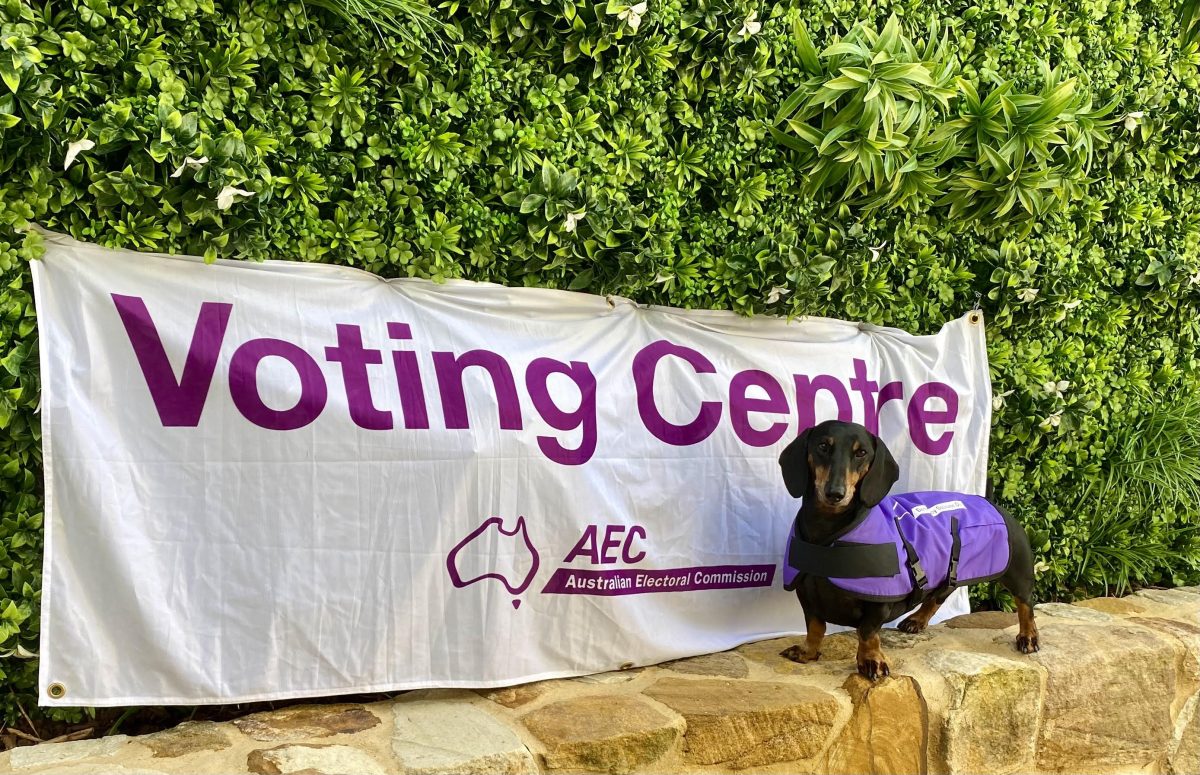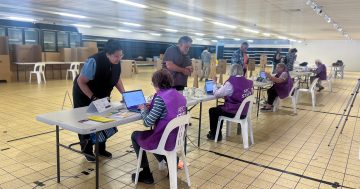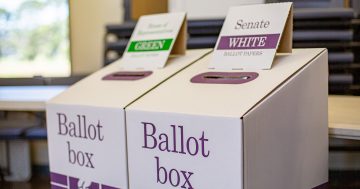
Fred the election sausage dog has no need to bone up on his political history, he just has to ask his human, the Australian Electoral Commissioner, Tom Rogers – or sniff out the MOAD exhibition. Photo: AEC.
So, you think you know everything there is to know about how our democracy works?
Take this quick quiz. (Sorry, no prizes, just the warm fuzzy feeling that when it comes to democracy, you really take the (dog) biscuit.)
If you are feeling a little at sea, all the things you’ve ever wanted to know but perhaps been too politically correct to ask are now available at the perfect location, the Museum of Australian Democracy (MOAD), at Old Parliament House.

The AEC’s Alex Morris with Lorraine Johnson from MOAD and Pat Callanan from the AEC in front of one of the early images of how Australians vote. Photo: Sally Hopman.
The Australian Electoral Commission (AEC) has joined forces with MOAD to present an exhibition, Writs to Referendums: Celebrating Australia’s unique electoral system.
Project manager for the exhibition, Lorraine Johnson, said the idea was to present visitors with a behind-the-scenes view of the electoral process, showing how there was so much more involved in the operation than just turning up on election day to vote or ensuring your name was on the electoral roll.
“It shows you everything that happens, from the scene on polling day to how to find out about the people you vote for and what divisions they represent,” she said.
“It’s all part of the education program we do here at MOAD,” she added, in the interactive exhibition where, as you walk in, flying ballot papers zoom around the room – to the delight of the visiting schoolchildren.
But there’s one section that goes back in time, a wall of old and new election posters, showing how we’ve changed over the years, while others target specific audiences like farmers out in the bush to First Nations Australians in their remote communities to cafe-society folk living in the cities.
Apart from explaining how democracy works from behind the scenes right up to election day, the exhibition is also timely for its coverage of referendums with the upcoming Indigenous Voice to Parliament referendum, although Ms Johnson said this did not play a part in the exhibition’s early planning.
For example, one of the questions visitors are asked is: Who has the power to change electoral sections of the Constitution? (Answer: The Constitution can only be altered after a referendum. But Parliament can change the Commonwealth Electoral ACT 1918.)

AEC Electoral Commissioner Tom Rogers opens the MOAD exhibition with the Chair of Parliament’s Joint Standing Committee on Electoral Matters, Kate Thwaites MP. Photo: AEC.
Alex Morris from the AEC said a special feature of the exhibition paid tribute to the core of dedicated workers who, each election, worked the polling booths, in a variety of jobs to ensure that everyone who had the right to vote, did so.
“We couldn’t do what we do without them,” he said. “We have one man who has been working all the elections since 1975. His knowledge about how things work is invaluable. But one of the best things is that he engages so well with the younger people who come in to work with us for the first time – and they both end up benefitting from sharing knowledge.”
The free Writs to Referendums exhibition is open daily at MOAD, from 9 am to 5 pm.


















